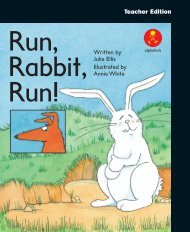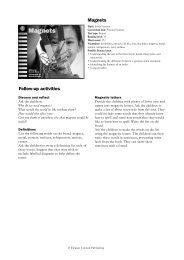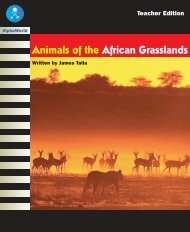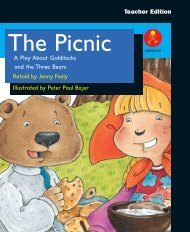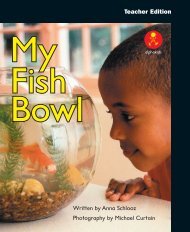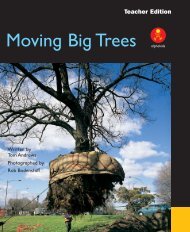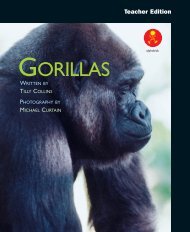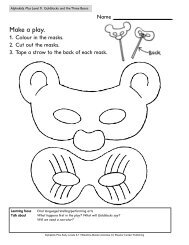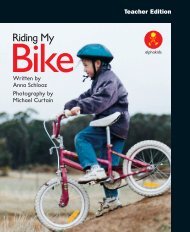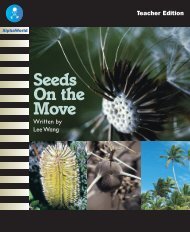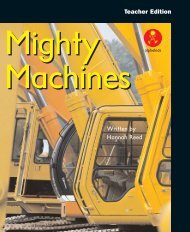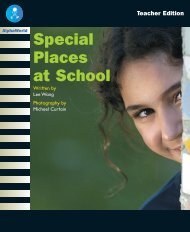Amazing Sea Lizards
Amazing Sea Lizards
Amazing Sea Lizards
Create successful ePaper yourself
Turn your PDF publications into a flip-book with our unique Google optimized e-Paper software.
Teacher EditionAlphaWorld<strong>Amazing</strong> <strong>Sea</strong> <strong>Lizards</strong>Written by Marilyn Woolley
Setting the contextCould a lizard swim in the sea?Discuss the children’s responses.If a lizard could swim in the sea, what might itlook like?The children could draw what they imaginea sea lizard would look like.Front coverShow the front cover.This book is called <strong>Amazing</strong> <strong>Sea</strong> <strong>Lizards</strong>.It is about lizards that swim in the sea.Do these lizards look like the one you drew?Title pageTurn to the title page.The title page tells us the title of the book andthe name of the author.What else can you see on this page?1
<strong>Amazing</strong> <strong>Sea</strong> <strong>Lizards</strong> Pages 2–5?TalkthroughTurn to the contents page.This is the contents page. It tells us what information will be inthe book.Read out the section headings.Do any of these headings surprise you? Why?What does it look like these lizards are doing?Turn to pages 4–5The only place sea lizards live is the Galapagos Islands.These are the only lizards that go into the sea. Do you think sealizards are good swimmers?Observe and supportDo the children use an understanding of letter-soundrelationships to check words?You read the word ‘Galapagos’. How did you know it was‘Galapagos’?What did you look at?What did you think about?When needed, you might say:Look at the start of the word. What sound might these lettersmake together?Look at the end of the word. What do you notice?Try saying the word.2
<strong>Amazing</strong> <strong>Sea</strong> <strong>Lizards</strong> Pages 6–9?TalkthroughTurn to pages 6–7<strong>Sea</strong> lizards can grow to more than a metre long. What else doyou notice about the way sea lizards look?What do you notice about their mouths?Look at their strong feet and claws. Why would this sort of lizardneed such strong feet?Turn to pages 8–9This section is called ‘Salty sneezes’. Why do you think the lizardssneeze?The lizards have lumps of salt on their heads. Can you see themin the photos?Observe and supportCan the children use information in the text and thephotographs to understand new words?What is a snout? What helped you to work that out?If the children are unsure about what the word means youmight say:Look at the picture. Where is the lump of salt? What part of thelizard’s face is it near?What is another word for this part of the body?Can you explain what a snout is?4
<strong>Amazing</strong> <strong>Sea</strong> <strong>Lizards</strong> Pages 10–13?TalkthroughTurn to pages 10–11<strong>Sea</strong> lizards live in groups. Some groups have more than 3000lizards living together. Why might the lizards choose to live ingroups? What are these groups of lizards doing?Turn to pages 12-13<strong>Sea</strong> lizards warm up in the mornings by lying on rocks in the sun.What do they do to cool down?Observe and supportDo the children search for a range of information on the pageto support their reading?When you looked at the pictures before you read the page, whatwere you looking for? How did that help you?What else did you check?If any of the children are having difficulty decoding the text,you might say:Look at the pictures. What information do they give you?What sort of word do we need?What sounds right?What does the word look like?6
<strong>Amazing</strong> <strong>Sea</strong> <strong>Lizards</strong> Pages 14–17?TalkthroughTurn to pages 14–15After swimming in the water, the lizards warm up by lying on arock. When it gets cooler, the lizards lie on top of each other tokeep warm. Why do lizards and other reptiles do this? (They arecold-blooded.)Turn to pages 16–17This section is called ‘Little lizards’. Baby lizards hatch from eggs.Do you think the mother looks after the baby lizards when theyare born or can they look after themselves? Why do you think so?Observe and supportCan the children understand the inferences in the text?Why do the sea lizards swim during the middle of the day?How do the lizards keep warm?What might happen to a lizard if it lived alone?Why does the mother lizard stay near the nest?8
<strong>Amazing</strong> <strong>Sea</strong> <strong>Lizards</strong> Pages 18–20?TalkthroughThe only place in the world where these lizards are found is theGalapagos Islands.Why do we need to protect the Galapagos Islands?What would visitors need to think about when visiting theseislands?Turn to page 20This is the index. An index lists words from the book and thepages where information about these words can be found.Where would I find information about eggs?Observe and supportDo the children read the text fluently?I liked the way you read that. It was clear and it was easy for meto understand the information.If needed, you could model fluent reading. Can you make itsound like I do?The child could then read the text alone.10
<strong>Amazing</strong> <strong>Sea</strong> <strong>Lizards</strong>After readingBeing a meaning makerEncourage the children to supporttheir answers to these questions withevidence from the book:Where are sea lizards found?Why do you think they are found only inone place in the world?Why do sea lizards live in groups?Why do visitors need to be careful whenvisiting the Galapagos Islands?What might happen if there werechanges to the environment of theGalapagos Islands?Being a code breakerExplore the following languagefeatures:• Words with two, three and foursyllables• Homophones: to/too/two, for/four• Punctuation: capital letters, commas,full stops• Words with double letters: cool, eggs,feed, feet, green, keep, looks, middle,need, seaweed, sneezing, swimming,tooBeing a text userWhat sort of text is this? How do youknow?What is the purpose of a report?What features does this report have?How do these features help you to findinformation?Being a text criticWhat does the author think about sealizards?How might the author have found outabout sea lizards?What message does the author giveabout sea lizards?12
Responding to textThe children could create a conceptmap showing everything they now knowabout sea lizards.The children could make a sign givinginformation to visitors to the GalapagosIslands about how they need to behave.Writing linksWhat is this book about? What does the book tellus about sea lizards?Explain that this sort of text is called a report.A report organises information about a topic.Model writing a report on another group ofanimals.The children could draw a picture of asea lizard and label it. Encourage themto use the text to ensure they include thelizard’s most important features.Possible assessment focusCan the children:• explain the features of this report?• identify the number of syllables in selected words from thetext?• understand the text at an inferential level to explain howsea lizards live together?whole text activity sentence activity word activity
<strong>Amazing</strong> <strong>Sea</strong> <strong>Lizards</strong>Topic: Reptiles/ Animal Kingdom/ <strong>Sea</strong>Curriculum link: Natural ScienceText type: ReportReading level: 15Word count: 317Vocabulary: burrow, coastline, Galapagos,hatch, islands, lizard, protect, seaweed,sneezing, snout, stretching, visitorsPossible literacy focus:• Identifying the features of a report.• Identifying the number of syllables in words.• Using the text to make inferences about howsea lizards live.ESL possibilities:• Locate and discuss the meaning of verbs inthe text.• Read the text aloud with a focus onintonation.SummaryThis book is a report about sea lizards. It tellsus where these amazing creatures live, whatthey look like, how they behave and how theylook after themselves.AlphaWorldISBN 0- 7253- 3052- X9 780725 330521



